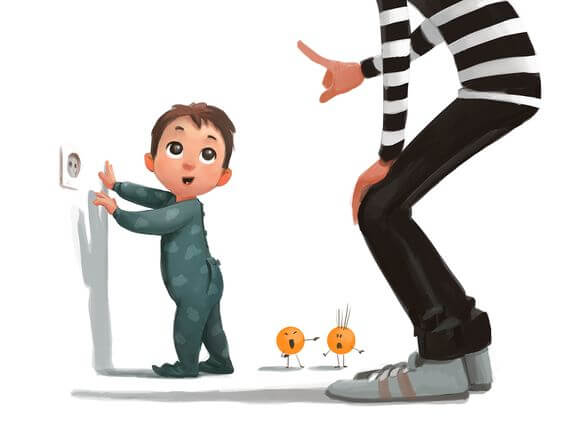The Naughty Children of the House: Curious Kids


Written and verified by the psychologist Valeria Sabater
Do you have naughty children at home? If so, we’d like to ask you a question. Do you really know what is driving them to be so restless? Why do they insist on touching everything and being defiant?
The answer to this question may be easier than you think. Behind this very active behavior there is a child who is full of life and only craves to discover the world.
Not all children are the same. Some children are calm and reflective, however, there are also children who are restless, curious and daring.
These naughty children are often labeled as “misbehavers.” They’re often misunderstood and that’s why you tend to judge them slightly.
It’s useful for parents to try to understand the hidden psychology behind their little mischievous child’s behavior.
Our patience put to the test
Children usually experience behavioral changes when they reach the age of two.
The so-called “terrible twos” show that the child is developing. Children start to manifest their clear desire to be independent. They also start to show a lot of curiosity.
They’re full of desire to know the inner workings of the world. Other common phrases during this start are “I don’t want to” or “I don’t feel like it.”
We must set limits and prevent the child from crossing the line. It’s better for parents to try to redirect their child’s innate curiosity. Helping them explore is the best way to train your child during this stage.

Controlling their impulses
Have you ever told your child “don’t throw that!” and as soon as you turn your back they do it anyway? If this happens and your child is younger than four years old, you should know that it’s normal.
Why? Because the areas of the brain that are involved in self-control are still immature when the child is younger than four. In fact, the areas of the brain that control self-control don’t fully mature until adolescence.
According to Tarullo, Obradovic and Gunna experts in child psychology, the development of self-control is long, slow and progressive.
As parents we have to keep in mind that just because the little one doesn’t have full control over their behavior, doesn’t mean we should let them do as they please.
Setting rules and limits will help guide the child to adopt appropriate behavior.
Beware, don’t overstimulate them
Kim John Payne, author of the well-known book Raising Simply explains that nowadays children sometimes accumulate the same level of stress as adults.
Did you know that the more tired a child, the more hyperactive and irritable they can become?
Naughty children are often just looking for our attention and time. However, we all need some “downtime” and moments of tranquility and calm where we can reflect.
As parents, we’re often the ones who overstimulate our children. We believe that the more activities the child takes part in the better their future will be.
You have to understand that exhausting the child or keeping them occupied will not solve their “problem.” It will only make them more restless.
What do naughty children need?
Firstly, naughty children need to be allowed to explore the world. They need to be able to touch, feel, experiment and find out how things work.
When they manage to satisfy their curiosity, new neuronal connections are established in their brains. This means they’re actively learning.
Just like with adults, the stimuli around them are key to their development.

Denying them the space to move around and giving them orders like “sit down and don’t move all afternoon” does more harm than good. This method limits their learning and it stresses them out.
In order to help them we need to provide them with safe environments, and new learning opportunities. As parents we should never clip their wings nor their curiosity.
If we really want them to be better people tomorrow, we must first understand that they need balanced doses of guided activities.
We have to accompany them, guide them and orient them so that the activities they perform don’t get out of control.
Learning to be independent
It may be hard for us to admit and it may even hurt, however, when our children are between the age of 3 and 5, they enter another stage in which they’ll no longer need us with the same intensity as they did when they were babies.
They’ve grown up without us realizing it!
Now they have different needs. Although they still want us to hold their hands and take naps together, they also want to do some things on their own.
Is that so bad? Not at all, this is positive behavior because they’re learning how to be independent.
Erik Erikson explains that during this stage, children need to take initiative in many aspects of their daily life.
Let your child have some space and some responsibility (always under our supervision). This will promote their psychosocial development, putting them on the right route.
Remember, never use negative labels. You’ll soon understand that your child is actually daring, curious and wonderful.
Do you have naughty children at home? If so, we’d like to ask you a question. Do you really know what is driving them to be so restless? Why do they insist on touching everything and being defiant?
The answer to this question may be easier than you think. Behind this very active behavior there is a child who is full of life and only craves to discover the world.
Not all children are the same. Some children are calm and reflective, however, there are also children who are restless, curious and daring.
These naughty children are often labeled as “misbehavers.” They’re often misunderstood and that’s why you tend to judge them slightly.
It’s useful for parents to try to understand the hidden psychology behind their little mischievous child’s behavior.
Our patience put to the test
Children usually experience behavioral changes when they reach the age of two.
The so-called “terrible twos” show that the child is developing. Children start to manifest their clear desire to be independent. They also start to show a lot of curiosity.
They’re full of desire to know the inner workings of the world. Other common phrases during this start are “I don’t want to” or “I don’t feel like it.”
We must set limits and prevent the child from crossing the line. It’s better for parents to try to redirect their child’s innate curiosity. Helping them explore is the best way to train your child during this stage.

Controlling their impulses
Have you ever told your child “don’t throw that!” and as soon as you turn your back they do it anyway? If this happens and your child is younger than four years old, you should know that it’s normal.
Why? Because the areas of the brain that are involved in self-control are still immature when the child is younger than four. In fact, the areas of the brain that control self-control don’t fully mature until adolescence.
According to Tarullo, Obradovic and Gunna experts in child psychology, the development of self-control is long, slow and progressive.
As parents we have to keep in mind that just because the little one doesn’t have full control over their behavior, doesn’t mean we should let them do as they please.
Setting rules and limits will help guide the child to adopt appropriate behavior.
Beware, don’t overstimulate them
Kim John Payne, author of the well-known book Raising Simply explains that nowadays children sometimes accumulate the same level of stress as adults.
Did you know that the more tired a child, the more hyperactive and irritable they can become?
Naughty children are often just looking for our attention and time. However, we all need some “downtime” and moments of tranquility and calm where we can reflect.
As parents, we’re often the ones who overstimulate our children. We believe that the more activities the child takes part in the better their future will be.
You have to understand that exhausting the child or keeping them occupied will not solve their “problem.” It will only make them more restless.
What do naughty children need?
Firstly, naughty children need to be allowed to explore the world. They need to be able to touch, feel, experiment and find out how things work.
When they manage to satisfy their curiosity, new neuronal connections are established in their brains. This means they’re actively learning.
Just like with adults, the stimuli around them are key to their development.

Denying them the space to move around and giving them orders like “sit down and don’t move all afternoon” does more harm than good. This method limits their learning and it stresses them out.
In order to help them we need to provide them with safe environments, and new learning opportunities. As parents we should never clip their wings nor their curiosity.
If we really want them to be better people tomorrow, we must first understand that they need balanced doses of guided activities.
We have to accompany them, guide them and orient them so that the activities they perform don’t get out of control.
Learning to be independent
It may be hard for us to admit and it may even hurt, however, when our children are between the age of 3 and 5, they enter another stage in which they’ll no longer need us with the same intensity as they did when they were babies.
They’ve grown up without us realizing it!
Now they have different needs. Although they still want us to hold their hands and take naps together, they also want to do some things on their own.
Is that so bad? Not at all, this is positive behavior because they’re learning how to be independent.
Erik Erikson explains that during this stage, children need to take initiative in many aspects of their daily life.
Let your child have some space and some responsibility (always under our supervision). This will promote their psychosocial development, putting them on the right route.
Remember, never use negative labels. You’ll soon understand that your child is actually daring, curious and wonderful.
All cited sources were thoroughly reviewed by our team to ensure their quality, reliability, currency, and validity. The bibliography of this article was considered reliable and of academic or scientific accuracy.
- Gonzáelez, J. V. R. (2016). La curiosidad en el desarrollo cognitivo: análisis teórico. Folhmyp, (6), 1-20. https://revistas.pedagogica.edu.co/index.php/FHP/article/view/6416
- Kreitler, S., Zigler, E., & Kreitler, H. (1975). The nature of curiosity in children. Journal of school psychology, 13(3), 185-200. https://www.sciencedirect.com/science/article/pii/0022440575900023
- Hutt, C. (1970). Curiosity in young children. Science journal. https://psycnet.apa.org/record/1970-20592-001
This text is provided for informational purposes only and does not replace consultation with a professional. If in doubt, consult your specialist.








